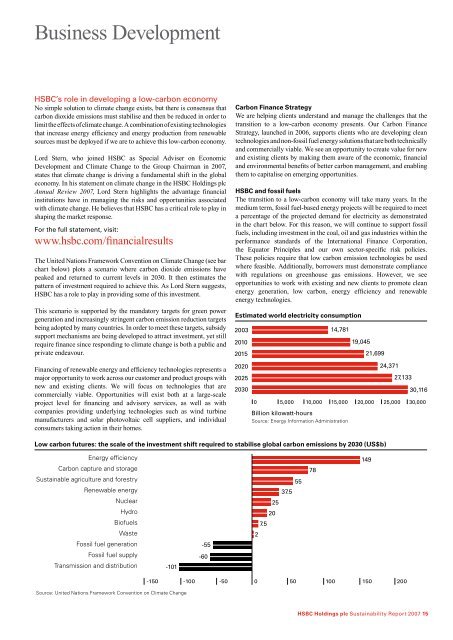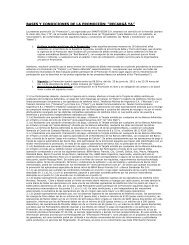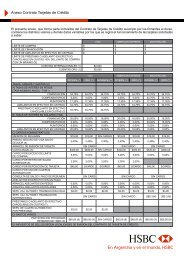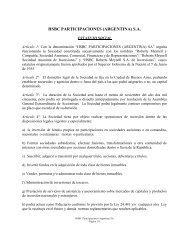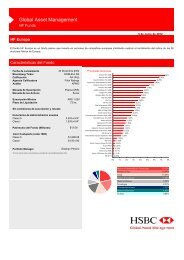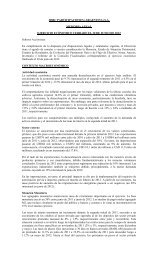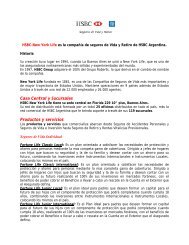HSBC Holdings plc Sustainability Report 2007
HSBC Holdings plc Sustainability Report 2007
HSBC Holdings plc Sustainability Report 2007
Create successful ePaper yourself
Turn your PDF publications into a flip-book with our unique Google optimized e-Paper software.
Business Development<br />
<strong>HSBC</strong>’s role in developing a low-carbon economy<br />
No simple solution to climate change exists, but there is consensus that<br />
carbon dioxide emissions must stabilise and then be reduced in order to<br />
limit the effects of climate change. A combination of existing technologies<br />
that increase energy efficiency and energy production from renewable<br />
sources must be deployed if we are to achieve this low-carbon economy.<br />
Lord Stern, who joined <strong>HSBC</strong> as Special Adviser on Economic<br />
Development and Climate Change to the Group Chairman in <strong>2007</strong>,<br />
states that climate change is driving a fundamental shift in the global<br />
economy. In his statement on climate change in the <strong>HSBC</strong> <strong>Holdings</strong> <strong>plc</strong><br />
Annual Review <strong>2007</strong>, Lord Stern highlights the advantage financial<br />
institutions have in managing the risks and opportunities associated<br />
with climate change. He believes that <strong>HSBC</strong> has a critical role to play in<br />
shaping the market response.<br />
For the full statement, visit:<br />
www.hsbc.com/financialresults<br />
The United Nations Framework Convention on Climate Change (see bar<br />
chart below) plots a scenario where carbon dioxide emissions have<br />
peaked and returned to current levels in 2030. It then estimates the<br />
pattern of investment required to achieve this. As Lord Stern suggests,<br />
<strong>HSBC</strong> has a role to play in providing some of this investment.<br />
This scenario is supported by the mandatory targets for green power<br />
generation and increasingly stringent carbon emission reduction targets<br />
being adopted by many countries. In order to meet these targets, subsidy<br />
support mechanisms are being developed to attract investment, yet still<br />
require finance since responding to climate change is both a public and<br />
private endeavour.<br />
Financing of renewable energy and efficiency technologies represents a<br />
major opportunity to work across our customer and product groups with<br />
new and existing clients. We will focus on technologies that are<br />
commercially viable. Opportunities will exist both at a large-scale<br />
project level for financing and advisory services, as well as with<br />
companies providing underlying technologies such as wind turbine<br />
manufacturers and solar photovoltaic cell suppliers, and individual<br />
consumers taking action in their homes.<br />
Carbon Finance Strategy<br />
We are helping clients understand and manage the challenges that the<br />
transition to a low-carbon economy presents. Our Carbon Finance<br />
Strategy, launched in 2006, supports clients who are developing clean<br />
technologies and non-fossil fuel energy solutions that are both technically<br />
and commercially viable. We see an opportunity to create value for new<br />
and existing clients by making them aware of the economic, financial<br />
and environmental benefits of better carbon management, and enabling<br />
them to capitalise on emerging opportunities.<br />
<strong>HSBC</strong> and fossil fuels<br />
The transition to a low-carbon economy will take many years. In the<br />
medium term, fossil fuel-based energy projects will be required to meet<br />
a percentage of the projected demand for electricity as demonstrated<br />
in the chart below. For this reason, we will continue to support fossil<br />
fuels, including investment in the coal, oil and gas industries within the<br />
performance standards of the International Finance Corporation,<br />
the Equator Principles and our own sector-specific risk policies.<br />
These policies require that low carbon emission technologies be used<br />
where feasible. Additionally, borrowers must demonstrate compliance<br />
with regulations on greenhouse gas emissions. However, we see<br />
opportunities to work with existing and new clients to promote clean<br />
energy generation, low carbon, energy efficiency and renewable<br />
energy technologies.<br />
Estimated world electricity consumption<br />
2003<br />
2010<br />
2015<br />
2020<br />
2025<br />
2030<br />
0<br />
5,000<br />
10,000<br />
14,781<br />
15,000<br />
Billion kilowatt-hours<br />
Source: Energy Information Administration<br />
19,045<br />
20,000<br />
21,699<br />
24,371<br />
25,000<br />
27,133<br />
30,116<br />
30,000<br />
Low carbon futures: the scale of the investment shift required to stabilise global carbon emissions by 2030 (US$b)<br />
Energy efficiency<br />
Carbon capture and storage<br />
Sustainable agriculture and forestry<br />
Renewable energy<br />
Nuclear<br />
Hydro<br />
Biofuels<br />
Waste<br />
Fossil fuel generation<br />
Fossil fuel supply<br />
Transmission and distribution<br />
-101<br />
-55<br />
-60<br />
55<br />
37.5<br />
25<br />
20<br />
7.5<br />
2<br />
78<br />
149<br />
Source: United Nations Framework Convention on Climate Change<br />
-150 -100 -50 0 50 100 150 200<br />
<strong>HSBC</strong> <strong>Holdings</strong> <strong>plc</strong> <strong>Sustainability</strong> <strong>Report</strong> <strong>2007</strong> 15


